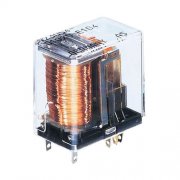Electromagnetic Relays (also known as traditional mechanical relay, Electromechanical Relay, EMR), are widely used in many fields as the earlist relay. Unlike solid state relays(SSR), electromagnetic relays use mechanical action components with contacts as the switching components (such as Coil-Reed Electromagnetic Relay). When the input terminal of the electromagnetic relay is added with control signals, the coil inside the electromagnetic relay is energized by the input current to generate an electromagnetic field to attract the movable component, so that the movable contact in the movable component contacts with the static contact in the non-movable component to turn on the output circuit of the electromagnetic relay. Mechanical relays are composed entirely of simple mechanical components, so its cost is very low, but these movable parts will generate jitter, sparks , and arcs during operation (which will make contact abnormal and shorten the service life), and also generate electro-magnetic Interference (which will make the input circuit and output circuit unstable). In addition, EMR will be interfered by interference signals, and cannot work in humid environments. Becasue the shortcomings and unreliability performance of electromechanical relays, the solid state relay has gradually replaced the position of the mechanical relay. >>More information about the differences between SSR and EMR>>

